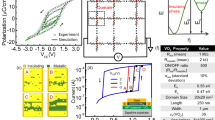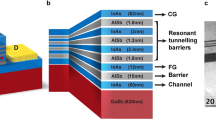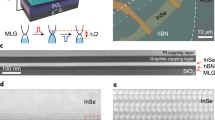Abstract
Non-volatile memory devices that can operate reliably at high temperature are required for the development of extreme environment electronics. However, creating such devices remains challenging. Here we report a non-volatile memory device that is based on an aluminium scandium nitride (Al0.68Sc0.32N) ferroelectric diode and can operate at temperatures of up to 600 °C. The devices are composed of metal–insulator–metal structures of nickel/AlScN/platinum grown on 4-inch silicon wafers. They exhibit clear ferroelectric switching up to 600 °C with distinct on and off states. At 600 °C, the devices exhibit one million read cycles and readable on–off ratios above 1 for over 60 h. The operating voltages of the AlScN ferrodiodes are less than 15 V at 600 °C and are thus compatible with silicon-carbide-based high-temperature logic technology.
This is a preview of subscription content, access via your institution
Access options
Access Nature and 54 other Nature Portfolio journals
Get Nature+, our best-value online-access subscription
$29.99 / 30 days
cancel any time
Subscribe to this journal
Receive 12 digital issues and online access to articles
$119.00 per year
only $9.92 per issue
Buy this article
- Purchase on Springer Link
- Instant access to full article PDF
Prices may be subject to local taxes which are calculated during checkout




Similar content being viewed by others
Data availability
The data that support the findings of this study are available from the corresponding authors upon reasonable request.
References
Memory products for high temperature, harsh environments. TTSemiconductor (accessed 24 July 2023). https://ttsemiconductor.com/Memory-Products-For-High-Temperature-Harsh-Environments-1003-295.html
32-Mbit high-temp flash memory with serial peripheral interface (SPI) bus. Texas Instruments https://www.ti.com/product/SM28VLT32-HT (2013)
Neudeck, P. G. et al. Prolonged silicon carbide integrated circuit operation in Venus surface atmospheric conditions. AIP Adv. 6, 125119 (2016).
Balint, T. S., Cutts, J. A., Kolawa, E. A. & Peterson, C. E. Extreme environment technologies for space and terrestrial applications. In Proc. SPIE 6960, Space Exploration Technologies. 696006 https://doi.org/10.1117/12.780389 (2008).
Thompson, H. A. Application of commercial off-the-shelf technologies to aerospace gas turbine engine control. In IEEE Colloquium on COTS and Safety Critical Systems, (Digest No. 1997/013). 2/1-2/5 https://doi.org/10.1049/ic:19970092 (1997).
Chelnokov, V. & Syrkin, A. High temperature electronics using SiC: actual situation and unsolved problems. Mater. Sci. Eng. B 46, 248–253 (1997).
Werner, M. R. & Fahrner, W. R. Review on materials, microsensors, systems and devices for high-temperature and harsh-environment applications. IEEE Trans. Ind. Electron. 48, 249–257 (2001).
Suga, H. et al. Highly stable, extremely high-temperature, nonvolatile memory based on resistance switching in polycrystalline Pt nanogaps. Sci. Rep. 6, 34961 (2016).
Spry, D. J., Neudeck, P. G., Chen, L., Chang, C. W., Lukco, D. & Beheim, G. M. Experimental durability testing of 4H SiC JFET integrated circuit technology at 727 degrees centigrade. SPIE Defense + Commercial Sensing (DCS) 16 https://ntrs.nasa.gov/citations/20170000020 (2016).
Neudeck, P. G. et al. Extreme temperature 6H‐SiC JFET integrated circuit technology. Phys. Status Solidi A 206, 2329–2345 (2009).
Neudeck, P. G., Spry, D. J., Chen, L., Prokop, N. F. & Krasowski, M. J. Demonstration of 4H-SiC digital integrated circuits above 800 °C. IEEE Electron. Device Lett. 38, 1082–1085 (2017).
Lee, K. & Kang, S. H. Design consideration of magnetic tunnel junctions for reliable high-temperature operation of STT-MRAM. IEEE Trans. Magn. 46, 1537–1540 (2010).
Wong, H.-S. P. et al. Phase change memory. Proc. IEEE 98, 2201–2227 (2010).
Ye, C. et al. Physical mechanism and performance factors of metal oxide based resistive switching memory: a review. J. Mater. Sci. Technol. 32, 1–11 (2016).
Muneyasu, M. et al. A 28nm embedded SG-MONOS flash macro for automotive achieving 200MHz read operation and 2.0 MB/s write throughput at Tj of 170 °C. IEICE Tech. Rep. 115, 15–19 (2015).
Singh, P., Arya, D. S. & Jain, U. MEM-FLASH non-volatile memory device for high-temperature multibit data storage. Appl. Phys. Lett. 115, 043501 (2019).
Morgul, M. C., Sakib, M. N. & Stan, M. Reliable processing in flash with high temperature. In 2021 IEEE International Integrated Reliability Workshop (IIRW). 1–6 https://doi.org/10.1109/IIRW53245.2021.9635624 (2021).
Govoreanu, B. & Van Houdt, J. On the roll-off of the activation energy plot in high-temperature flash memory retention tests and its impact on the reliability assessment. IEEE Electron. Device Lett. 29, 177–179 (2008).
Sato, K., Hayashi, Y., Masaoka, N., Tohei, T. & Sakai, A. High-temperature operation of gallium oxide memristors up to 600 K. Sci. Rep. 13, 1261 (2023).
Yang, N. et al. Ultra-wide temperature electronic synapses based on self-rectifying ferroelectric memristors. Nanotechnology 30, 464001 (2019).
Liu, X. et al. Reconfigurable compute-in-memory on field-programmable ferroelectric diodes. Nano Lett. 22, 7690–7698 (2022).
Liu, X. et al. Aluminum scandium nitride-based metal–ferroelectric–metal diode memory devices with high on/off ratios. Appl. Phys. Lett. 118, 202901 (2021).
Kim, K.-H., Karpov, I., III, Olsson, R. H. & Jariwala, D. Wurtzite and fluorite ferroelectric materials for electronic memory. Nat. Nanotechnol. https://doi.org/10.1038/s41565-023-01361-y (2023).
Damjanovic, D. Ferroelectric, dielectric and piezoelectric properties of ferroelectric thin films and ceramics. Rep. Prog. Phys. 61, 1267 (1998).
Zheng, J. X. et al. Ferroelectric behavior of sputter deposited Al0. 72Sc0. 28N approaching 5 nm thickness. Appl. Phys. Lett. 122, 222901 (2023).
Kim, K.-H. et al. Scalable CMOS back-end-of-line-compatible AlScN/two-dimensional channel ferroelectric field-effect transistors. Nat. Nanotechnol. https://doi.org/10.1038/s41565-023-01399-y (2023).
Islam, M. R. et al. On the exceptional temperature stability of ferroelectric Al1−xScxN thin films. Appl. Phys. Lett. 118, 232905 (2021).
Wolff, N. et al. Al1−xScxN thin films at high temperatures: Sc-dependent instability and anomalous thermal expansion. Micromachines 13, 1282 (2022).
Drury, D., Yazawa, K., Zakutayev, A., Hanrahan, B. & Brennecka, G. High-temperature ferroelectric behavior of Al0.7Sc0.3N. Micromachines 13, 887 (2022).
Spry, D. J. et al. Processing and Characterization of Thousand-Hour 500 °C Durable 4H-SiC JFET Integrated Circuits. In IMAPSource Proceedings. 249–256 https://doi.org/10.4071/2016-HITEC-249 (2016).
Huang, X. et al. Exploring the shape and distribution of electrodes in membraneless enzymatic biofuel cells for high power output. Int. J. Hydrog. Energy 46, 17414–17420 (2021).
Zhu, W. et al. Strongly temperature dependent ferroelectric switching in AlN, Al1−xScxN, and Al1−xBxN thin films. Appl. Phys. Lett. 119, 062901 (2021).
Meier, D. & Selbach, S. M. Ferroelectric domain walls for nanotechnology. Nat. Rev. Mater. 7, 157–173 (2022).
Wang, J., Park, M. & Ansari, A. Thermal characterization of ferroelectric aluminum scandium nitride acoustic resonators. In Proc. 2021 IEEE 34th International Conference on Micro Electro Mechanical Systems (MEMS) 214–217 https://doi.org/10.1109/MEMS51782.2021.9375203 (2021).
Gao, Z. et al. Super stable ferroelectrics with high Curie point. Sci. Rep. 6, 24139 (2016).
Liu, C. et al. Multiscale modeling of Al0.7Sc0.3N-based FeRAM: the steep switching, leakage and selector-free array. In 2021 IEEE International Electron Devices Meeting (IEDM). 8.1.1–8.1.4 https://doi.org/10.1109/IEDM19574.2021.9720535 (2021).
Guido, R. et al. Thermal stability of the ferroelectric properties in 100 nm-thick Al0.72Sc0.28N. ACS Appl. Mater. Interfaces 15, 7030–7043 (2023).
Guido, R., Mikolajick, T., Schroeder, U. & Lomenzo, P. D. Role of defects in the breakdown phenomenon of Al1−xScxN: from ferroelectric to filamentary resistive switching. Nano Lett. 23, 7213–7220 (2023).
Fichtner, S., Wolff, N., Lofink, F., Kienle, L. & Wagner, B. AlScN: a III-V semiconductor based ferroelectric. J. Appl. Phys. 125, 114103 (2019).
Gund, V. et al. Towards realizing the low-coercive field operation of sputtered ferroelectric ScxAl1-xN. In 21st International Conference on Solid-State Sensors, Actuators and Microsystems (Transducers) 1064–1067 https://doi.org/10.1109/Transducers50396.2021.9495515 (2021).
Wang, D., Wang, P., Wang, B. & Mi, Z. Fully epitaxial ferroelectric ScGaN grown on GaN by molecular beam epitaxy. Appl. Phys. Lett. 119, 111902 (2021).
Grigoriev, A., Azad, M. M. & McCampbell, J. Ultrafast electrical measurements of polarization dynamics in ferroelectric thin-film capacitors. Rev. Sci. Instrum. 82, 124704 (2011).
Fichtner, S. et al. Ferroelectricity in AlScN: Switching, imprint and sub-150 nm films. In 2020 Joint Conference of the IEEE International Frequency Control Symposium and International Symposium on Applications of Ferroelectrics (IFCS-ISAF). 1–4 https://doi.org/10.1109/IFCS-ISAF41089.2020.9234883 (2020).
Wang, D. et al. Ferroelectric switching in sub-20 nm aluminum scandium nitride thin films. IEEE Electron. Device Lett. 41, 1774–1777 (2020).
Acknowledgements
D.J., R.H.O., D.K.P. and G.K. acknowledge primary support for this work from AFRL via the FAST programme. D.J. and K.-H.K. acknowledge primary support from the Air Force Office of Scientific Research (AFOSR) GHz-THz program FA9550-23-1-0391. N.G. and D.M. gratefully acknowledge support from AFOSR GHz-THz program grant number FA9550-24RYCOR011. Z.H. acknowledges support from the VIPER programme of the Vagelos Institute for Energy Science and Technology at Penn. V.S.P. acknowledges support for this work from AFRL via the National Research Council (NRC) senior research associate fellowship programme. A portion of the sample fabrication, assembly and characterization were carried out at the Singh Center for Nanotechnology at the University of Pennsylvania, which is supported by the National Science Foundation (NSF) National Nanotechnology Coordinated Infrastructure Program grant NNCI-1542153. Additional support for the Nanoscale Characterization Facility at the Singh Center was provided by the NSF through the University of Pennsylvania Materials Research Science and Engineering Center (MRSEC) (DMR-2309043).
Author information
Authors and Affiliations
Contributions
D.J., R.H.O., D.K.P. and G.K. conceived the devices, measurements and sample fabrication idea/concepts. D.K.P. and G.K. fabricated the samples with assistance from X.D. and measured them at RT with assistance from Y.H., N.S. and K.-H.K. D.K.P. and D.C.M. performed all the high-temperature measurements with assistance from V.S.P. D.K.P. and D.C.M. analysed all the electrical data. Z.H. performed the theoretical fits to the high-temperature I–V data. P.M. performed electron microscopy and data analysis under supervision of E.A.S. D.J., R.H.O., N.R.G. and W.J.K. supervised and guided the project. D.K.P. and D.C.M. wrote the manuscript. All authors provided their inputs to the paper and Supplementary Information.
Corresponding authors
Ethics declarations
Competing interests
D.J., R.H.O., D.K.P., G.K. and Y.H. have a provisional patent filed on this work. The authors declare no other competing interests.
Peer review
Peer review information
Nature Electronics thanks Akira Sakai, Hiroshi Suga and the other, anonymous, reviewers for their contribution to the peer review of this work.
Additional information
Publisher’s note Springer Nature remains neutral with regard to jurisdictional claims in published maps and institutional affiliations.
Supplementary information
Supplementary Information
Supplementary Figs. 1–17, discussion and Tables 1 and 2.
Rights and permissions
Springer Nature or its licensor (e.g. a society or other partner) holds exclusive rights to this article under a publishing agreement with the author(s) or other rightsholder(s); author self-archiving of the accepted manuscript version of this article is solely governed by the terms of such publishing agreement and applicable law.
About this article
Cite this article
Pradhan, D.K., Moore, D.C., Kim, G. et al. A scalable ferroelectric non-volatile memory operating at 600 °C. Nat Electron (2024). https://doi.org/10.1038/s41928-024-01148-6
Received:
Accepted:
Published:
DOI: https://doi.org/10.1038/s41928-024-01148-6



